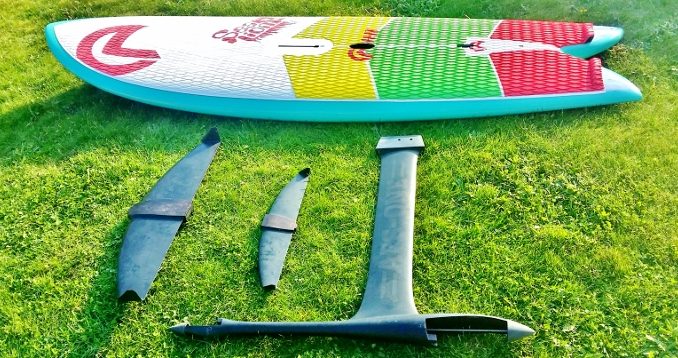
The following is reflective of our early experiences with windfoiling from 2017, when this article was first featured in Windsurfing UK. We should also add that the range of AFS hydro foils has now drastically changed. Stay tuned for AFS-2 foil review coming soon!
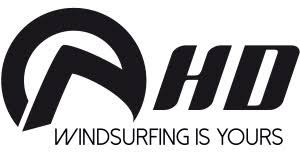 This isn’t the first time we’ve published a foil related gear article (see review of AHD’s Shark foil board elsewhere on the site) and it isn’t the first time we’ve featured AHD. Why? Because AHD were one of the first brand’s to put out mass market windsurf foil equipment so we thought it only right to start here first.
This isn’t the first time we’ve published a foil related gear article (see review of AHD’s Shark foil board elsewhere on the site) and it isn’t the first time we’ve featured AHD. Why? Because AHD were one of the first brand’s to put out mass market windsurf foil equipment so we thought it only right to start here first.
As we near the end of 2017 it’ll be the year known as ‘the one windsurf foiling properly took off’. Most major brands now have flying gear in their range and some are putting considerable amounts of time, money and R&D into making it truly accessible for the masses. What was once a niche within a niche – and a pricey one at that – is now broader in appeal. Those long in the tooth, world weary windsurfing stalwarts have even had a glint in the eyes upon the mention of foiling. The positive buzz surrounding hovering in light winds can’t be ignored even if there’s still some debate about how things will pan out. But back to this particular story…
This ain’t no review
Before we go on this article isn’t so much an equipment review as a ‘these are our foil findings whilst using the Sealion Wings 7.6ft’. There’s a long way to go before we consider ourselves experts. Instead what we’re attempting to do here is convey how things have been during our time with this kit and hopefully inspire other riders to get involved with flying.
Back to the start
We’ve already mentioned it but our foil journey started with AHD’s Carbon Shark: a 100% dedicated foiling platform that when coupled with the brand’s AFS-1 foil is set to get riders flying in sub-10 knots.
Being honest it took us a while to get familiar with. Conditions DO play a massive part when learning. Gusty winds and choppy sea states don’t do anything to help the cause. At the very beginning it’s advisable to actually have some wind in the mix (12 ish knots steady side shore breeze being ideal). Trying to learn the ropes in uber light airs (sub 10 knots) is actually quite technical and for a while we were flummoxed. Fast forward a few sessions and things began to click and before long we could claim success.
Kit swapSwapping the Shark for AHD’s Sealion Wings 7.6ft really opened the foiling doors, however. Even though on paper the 7.6ft is slightly smaller, in terms of dimensions, it’s a sled that’s elevated (pun intended!) our foiling game no end.
With its re-enforced AHD foil box, 100% carbon lay-up and multi-sport diversity (wave windSUP, SUP surfer, wind foil and SUP foil) the Sealion Wings 7.6ft has been, for us at least, a complete game changer. It’s the only windSUP we’ve tried that performs as a wave board should in surf with a sail attached (see the Sealion Wings 7.6ft write up from WSUK issue four) and it rips around the break in SUP surf mode.
As a board alone the Sealion is a unique shape. It’s pretty hard to miss with that pronounced swallow tail and twin 16cm fins protruding from the underside. Add to the mix its super comfy and colourful deckpad, well positioned mast track and cleverly shaped hull contours and you have a board that’s desirable without additional foil bits. We’ve said it before but in our opinion the Sealion range should be WAY more popular in the UK than it is. It’s a board that could/will save many a session – especially if you have waves in mind.
Taking off – sans footstraps
One of the biggest advantages for our foiling exploits is the 7.6ft’s lack of deck clutter. Some foiler tips suggest front straps help lock riders onto the board which can help during take offs. We actually found having the ability to tweak foot placement was more rewarding. With just a few millimetres of movement riders can find the optimum position without being constrained. Depending on wind strength, gustiness, tootsies can move to optimums. If it’s on the lighter side, for instance, then feet planted more centrally is better. As the wind increases you can then move outboard accordingly.
The back foot also doesn’t really need a strap. Again, tips from the top suggest removing back types during learning anyway. We’d then not see any reason to revert. Also, with AHD’s AFS-1 foil sometimes it’s key to being able to bring your back foot closer to the mast, while at other times a wider stance is needed.
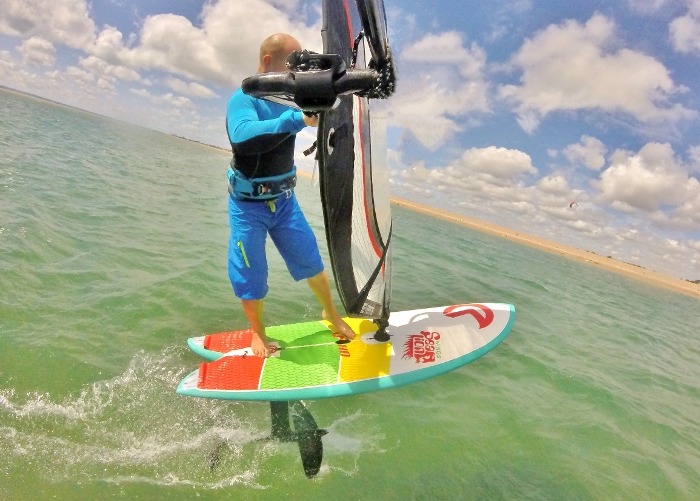
Lift control
AHD’s AFS-1 foil is designed to be early flying and deliver riders to fully foiling in light airs. With a 5.3m, and (again) steady wind, lift off became increasingly efficient. We found in low wind strengths a sail with grunty bottom end power helped during lift offs. Five batten rigs tended to be the most balanced for upright stance foiling with slightly more downhaul/outhaul than you’d initially think helping control foil lift once flying. The whole rig thing is a fine line and a degree of experimentation is needed to find what works for you – we’re sure the subtle nuances of foiling will change depending on rider weight, ability and kit being used.
Moving up the wind strength spectrum and we’ve had the Sealion Wings 7.6ft and AFS-1 foil out in 22 knots with a 4.2m. Whilst doable it definitely feels like you’ve reached the foil’s limit. The main problem with too much sail power and/or too much wind is over foiling. You can tell when it’s going to happen. The foil starts gurgling, riders lift (what feels like) even higher and then suddenly you drop from the air – during initial phases resulting in a hard nose first touchdown and subsequent catapult.
You can control the sails power, and ultimately foil’s lift, by subtly sheeting in and out. As winds get stronger, however, you find dumping power more critical and the whole ride becomes uncomfortable. For sure, changing down sail sizes helps but you do reach a point…
(There is a new Mk2 front wing for the AFS-1, which we are about to be loaned. This is a higher speed foil, aimed at the wind foiling side of the performance envelope. This we are told lifts slightly later so needs more oomph for take off, but is smoother and more comfortable as speeds increase. We can’t wait to transition onto this while using the original wing for SUP foiling).
Something else we’ll mention is using harness and lines. We find ourselves often switching between hooked in and not bothering at all. If the wind’s stronger then committing slightly more to the harness helps with rig control (make sure lines are long). In light airs, when the sail needs to be more upright, not using the harness feels more efficient. Due to its frictionless ride, and reduced rig pressure, they’re not actually needed during flight. Initial hovering is helped by a degree of mastfoot pressure from being hooked in, but having taken off riders could unhook if they prefer. More proficient riders may scoff at this but from our experience it’s not essential.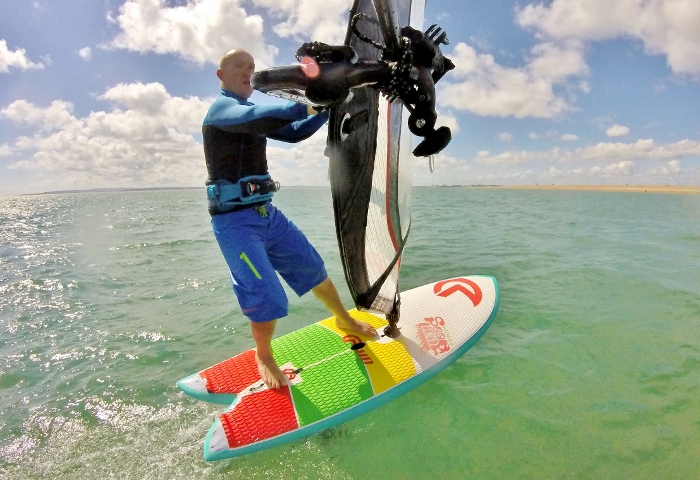
To side fin or notDuring our first forays with AHD’s Sealion Wings 7.6ft we attached the 16cm fibreglass side fins. In our head, although we appreciated this would increase drag, they would help with tracking on such a short board. Placebo or not it seemed to help during the taxiing phase. After a few sessions, however, we removed them altogether for foiling. The result being even earlier take offs and no catching the water if the ride becomes undulating – something that can cause sailors to drop off the foil.
Moves and manoeuvres
At time of writing we’re still mastering the art of gybing on the foil, which is one of the trickiest aspects. Get it right and there’s a hugely fulfilling sensation that washes over. Unfortunately it’s easy to get wrong!
Even sans footstrap gybing AHD’s Sealion Wings 7.6ft is doable though. Simply use your vision/head to subtly guide the kit in desired direction. An early rig change yields best results before a quick and efficient foot change, which will take a few goes to get dialled in. The AFS-1 foil, as with all foils, does want to steer you back onto original its course, so a degree of commitment is needed. That said, you’ll be surprised how stoked you’ll be when nailing a foiling turn.
Conclusion
It’s been a privilege to have had the opportunity to spend time getting to know a product like the AHD Sealion Wings 7.6ft and AFS-1 foil – big thanks to Jon Popkiss at Kai Sports for that. Without the time it wouldn’t have been possible to get to where we’re at now with foiling. In terms of kit AHD’s Sealion is hands down one of our favourite boards to ride. Usually not so gushing, but the fact it offers bona fide performance in wave windSUP mode whilst being able to accommodate paddling antics and, of course, windsurf foiling puts it high on Windsurfing UK’s list of essential products. Having the ability to switch sports with one (or rather two if you include the AFS-1 foil) piece of gear is key.
For windsurfers looking for a more efficient way to enjoy 12-18 knots worth of wind then a package like this could potentially suit thereby doing away with big rigs – the biggest sail you’ll need is 6m. If you’re after sub-10 knot foiling action then a 7m (ish) will still be needed, however.We’ll not lie: there’s a lot of crashing when learning to windsurf foil and a degree of perseverance will be needed. Wider boards may see a quicker learning groove but the Sealion Wings 7.6ft allows riders to develop a more subtle technique that will see all types of foiling kit able to be ridden from there on in.
For those contemplating windsurf foiling then the Sealion and AFS-1 package may suit – especially if you’re into multiple disciplines such as SUP. As foiling continues to evolve we’re sure other equally versatile products will emerge but for a brand that were there first AHD’s offering would be a good choice for many.
Price:
Sealion Wings Carbon 7’6 or 8’6 with Twin Fins = £1579
AFS-1 or AFS-1 Mk2 Carbon Foil complete = £1799
Either 7’6 or 8’6 Sealion Wings with the AFS-1 or AFS-1 Mk2 foil complete package = £3149
Info:
http://www.ahd-boards.com/models/sealion-wings-2/ and www.kaisports.co.uk
info@kaisports.co.uk Tel: 02380 840777

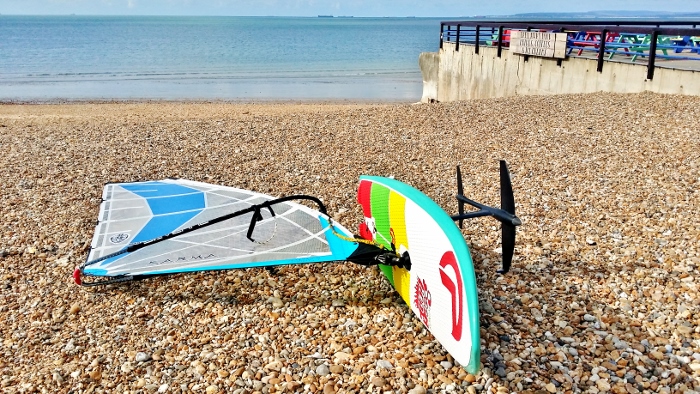
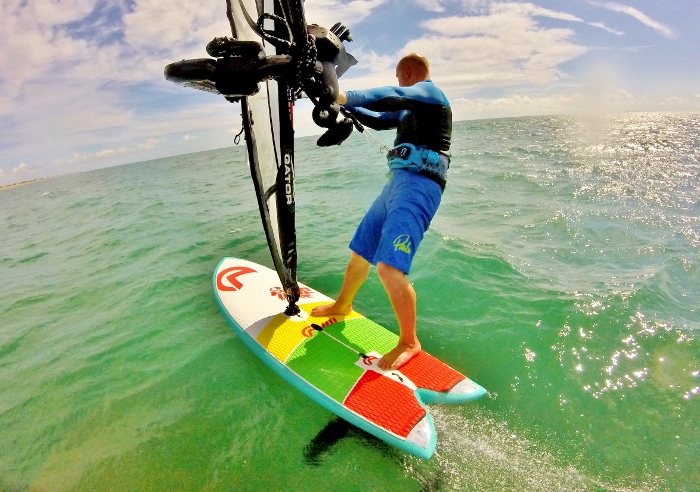
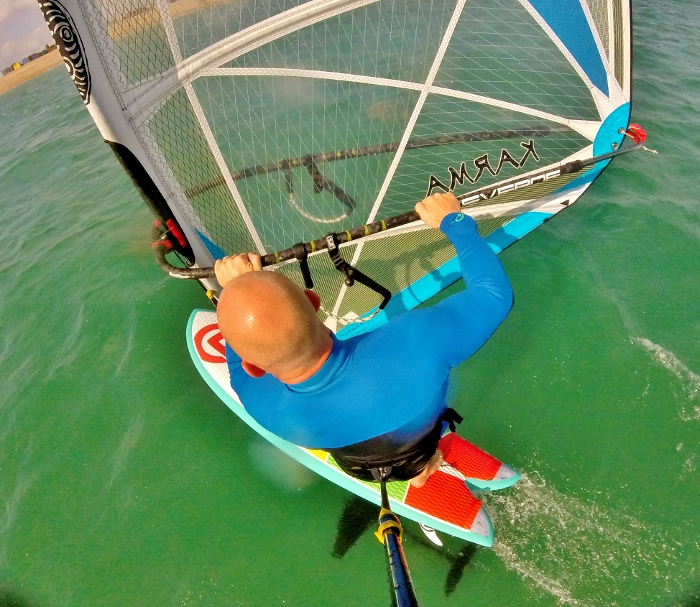
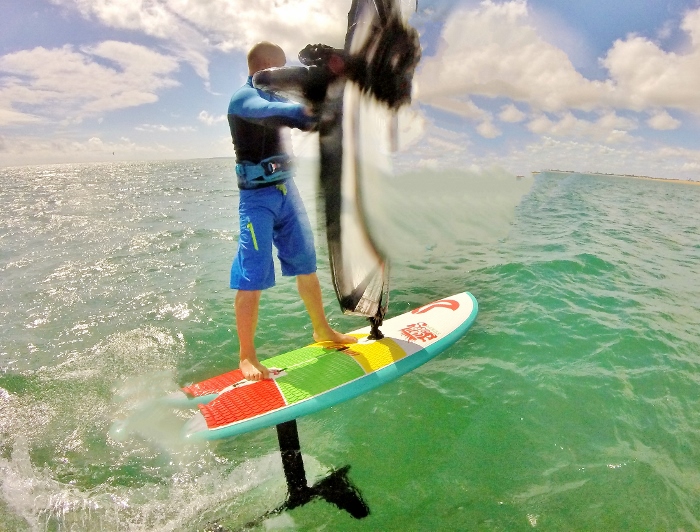

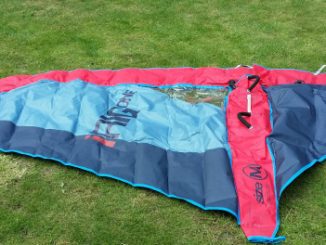
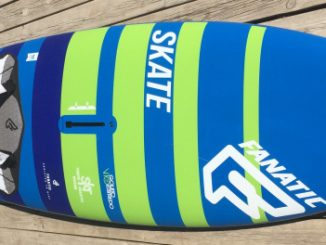
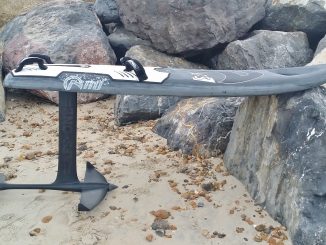
Leave a Reply